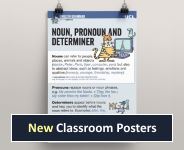Glossary: morphology
Explanation
Morphology is the study of the internal structure of words.
A word’s morphology is its internal make-up in terms of root words and suffixes or prefixes, as well as other kinds of change such as the change of mouse to mice.
Morphology may be used to produce different inflections of the same word (e.g. boy – boys), or entirely new words (e.g. boy – boyish) belonging to the same word family.
- dogs has the morphological make-up: dog + s.
- unhelpfulness has the morphological make-up: unhelpful + ness, where unhelpful = un + helpful and helpful = help + ful
A word that contains two or more root words is a compound (e.g. news+paper, ice+cream).
Morphology looks at how words can be made up from smaller parts, e.g. bright + -er gives brighter; white + board = whiteboard; study + -ed = studied.
Englicious contains many resources for English language in schools, but the vast majority of them require you to register and log in first. For more information, see What is Englicious?

